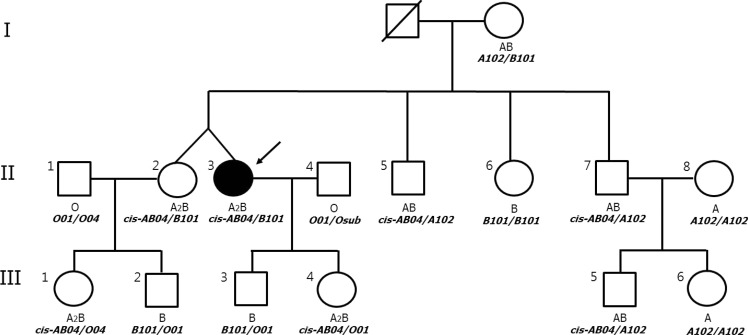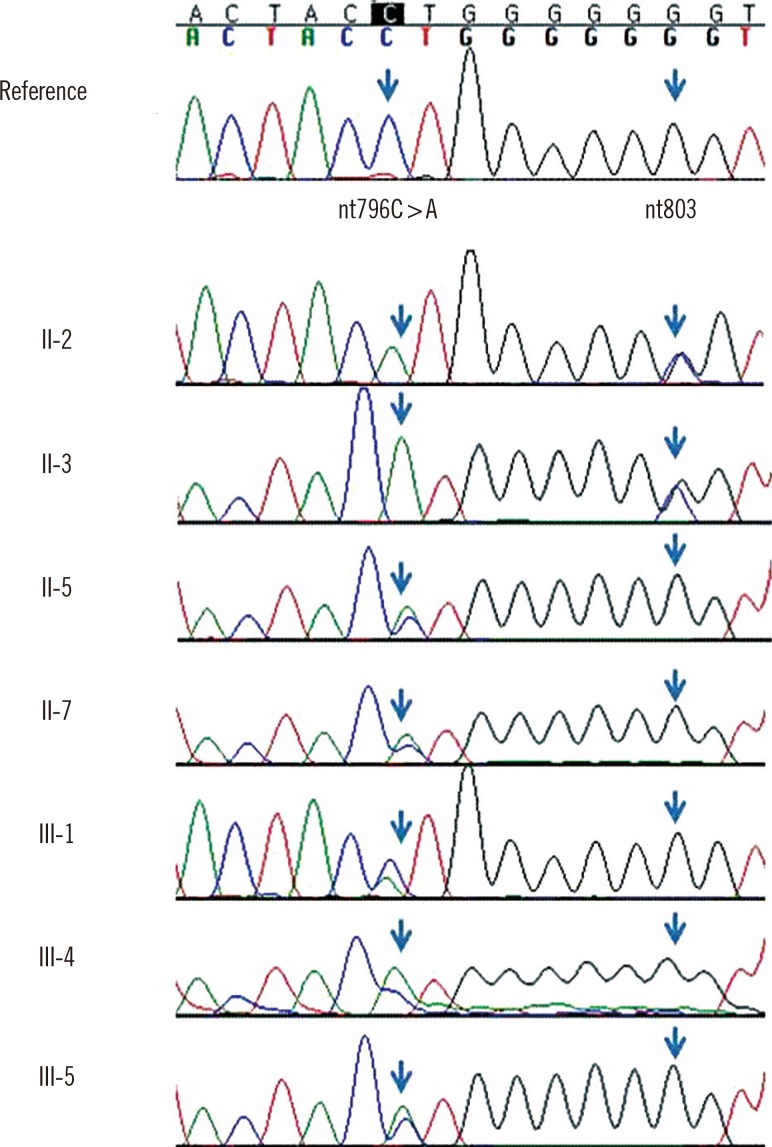Dear Editor,
Herein, we describe a family carrying the cis-AB04 allele through two generations; this is the first report of such a case in the Korean population.
Cis-AB is a very rare phenotype in the ABO blood group system and is characterized by the inheritance of an allele encoding an enzyme with both A and B activity [1]. Cis-AB red blood cells (RBCs) show various phenotypes depending on the partnering alleles, resulting in serological discrepancies. Blood group cis-AB is relatively more common in the Korean population and is reported to be the most common ABO subgroup in Korea [2]. At present, nine cis-AB alleles have been identified according to the Blood Group Antigen Gene Mutation Database. Among the cis-AB alleles, cis-AB01 is the most frequently observed allele in the Korean population [2] and cis-AB09 has also been reported [3], but reports on the other alleles are scarce.
A 46-yr-old woman (II-3, Fig. 1) visited the outpatient clinic of the Korea University Ansan Hospital for submucosal turbinectomy and septoplasty for chronic pansinusitis. Routine ABO typing of the proband's blood revealed an ABO discrepancy. ABO genotyping using peripheral blood from the proband was performed along with serological and molecular ABO typing of her family.
RBCs of the proband showed the A2B phenotype, characterized by 4+ agglutination with anti-A, anti-B, and anti-AB antisera, no agglutination with anti-A1 lectin, and an almost undetectable signal with anti-H antiserum. In the proband's serum, only traces of anti-A antibodies were found. She had negative results of irregular antibody screening. The RBCs of the proband's sister (II-2), nephew (III-1), and daughter (III-4) also showed the A2B phenotype.
For ABO genotyping, genomic DNA was extracted by using a DNA Extraction Kit (Qiagen Inc., Chatsworth, CA, USA) from peripheral blood. DNA fragments covering exons 6 and 7 of the ABO gene were amplified as previously described [4] by using a GeneAmp PCR System 9700 (Applied Biosystems, Foster City, CA, USA). The amplified PCR products were digested with restriction enzymes KpnI and AluI and fractionated by electrophoretic separation on agarose gels. Direct sequencing of the PCR product was carried out by using previously described methods [56] on an ABI 3130 Genetic Analyzer (Applied Biosystems), and the data were analyzed in the SEQUENCHER software (Gene Codes Corp., Ann Arbor, MI, USA) v.4.9. Direct sequencing of ABO exons 6 and 7 from the clones of the proband showed the c.796C>A substitution (p.Met266Leu) based on allele ABO*A102 and confirmed the presence of cis-AB04 (Fig. 2). The other allele corresponded to ABO*B101. Pedigree analysis revealed that three siblings (II-2, II-5, and II-7), the daughter (III-4), and two nephews (III-1, III-5) of the proband also carried the cis-AB04 allele (Fig. 2).
Allele cis-AB04 was first reported by two separate Taiwanese groups [78]. This allele is similar to allele A102 bearing the 796C>A substitution, which causes the Leu266Met mutation. The A102 allele is common among Asians and differs from the A101 allele by one nucleotide polymorphism, 467C>T (Pro-156Leu) and this amino acid substitution is unlikely to be deleterious to the activity of glycosyltransferase A (GTA) encoded by A102. On the other hand, amino acid residue 266 is known to be one of two critical positions determining A and B transferase specificity via complementary stereochemical relations between the side chains of these amino acid residues and the size of the donor sugar [1].
Phenotype cis-AB may be affected by a coinherited allele. In
our case, cis-AB04 that was inherited with an O01 or O04 allele, A101 allele, and B101 allele yielded phenotypes A2B, AB, and A2B, respectively. Other authors reported cis-AB04 in combination with O alleles and B101 resulting in the A2B phenotype, which matches our case [78]. In reverse grouping, there was one report describing the presence of an anti-A1 antibody of varying strength [7], and our results also showed the presence of a weak anti-A antibody in the proband and her family.
Transfusion for a patient with allele cis-AB04 can be challenging because blood type ABO can be misclassified. When blood type cis-AB04 is confirmed, theoretically, blood type O or B RBCs can be transfused, considering the presence of anti-A in serological tests of previously reported cases and our case. For platelet and fresh frozen plasma transfusion, blood type AB should be considered.
This case suggests that the possibility of cis-AB04 should be considered when diagnosing blood group cis-AB in the Korean population.
References
1. Yazer MH, Olsson ML, Palcic MM. The cis-AB blood group phenotype: fundamental lessons in glycobiology. Transfus Med Rev. 2006; 20:207–217. PMID: 16787828.
2. Cho D, Kim SH, Jeon MJ, Choi KL, Kee SJ, Shin MG, et al. The serological and genetic basis of the cis-AB blood group in Korea. Vox Sang. 2004; 87:41–43. PMID: 15260821.
3. Lee SY, Phan MT, Shin DJ, Shin MG, Park JT, Shin JW, et al. A novel cis-AB variant allele arising from a de novo nucleotide substitution c.796A>G (p.M266V) in the B glycosyltransferase gene. Transfus Med. 2015; 25:333–336. PMID: 26197879.
4. Fukumori Y, Ohnoki S, Yoshimura K, Nagao N, Shibata H, Tomita T, et al. Rapid detection of the cisAB allele consisting of a chimera of normal A and B alleles by PCR-RFLPs. Transfus Med. 1996; 6:337–344. PMID: 8981729.
5. Seo DH, Lee CY, Kim DW, Kim SI. ABO gene analysis of cis-AB and B subgroup in blood donors. Korean J Blood Transfus. 2000; 11:27–34.
6. Seo DH, Kim SY, Kim JY, Park KU, Kang SH, Park SS, et al. Molecular characteristics of A subgroups in Koreans. Korean J Blood Transfus. 2003; 14:212–222.
7. Tzeng CH, Chen YJ, Lyou JY, Chen PS, Liu HM, Hu HY, et al. A novel cis-AB allele derived from a unique 796C>A mutation in exon 7 of ABO gene. Transfusion. 2005; 45:50–55. PMID: 15647018.
8. Chen DP, Tseng CP, Wang WT, Wang MC, Tsao KC, Wu TL, et al. A novel cis-AB allele derived from the A transferase gene by nucleotide substitution C796A. Ann Clin Lab Sci. 2004; 34:437–442. PMID: 15648786.




 PDF
PDF ePub
ePub Citation
Citation Print
Print




 XML Download
XML Download